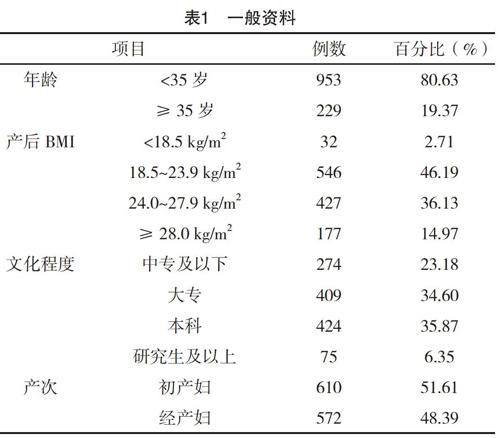产妇产褥期尿失禁情况及其治疗意愿调查
2019-01-22王巧红张俊清
王巧红 张俊清



【摘要】 目的:了解产妇产褥期尿失禁(urinary incontinence,UI)的发生情况以及产妇对UI治疗意愿的现状和影响因素。方法:以2017年7-12月在本院复查的1 182例产后6~8周的产妇为调查对象,采用国际尿失禁咨询委员会尿失禁问卷简表(ICIQ-SF)调查产妇产褥期UI发生情况,对UI产妇进一步调查其治疗意愿情况。结果:产褥期UI发生率17.68%(209/1 182),以压力性尿失禁(SUI)为主,占76.08%(159/209),其中64.11%(134/209)为轻度,30.14%(63/209)为中度,仅5.74%(12/209)为重度。在UI产妇中,60.29%(126/209)有治疗意愿,且UI严重程度及产妇的文化程度与产妇治疗意愿有关(P<0.05)。结论:产妇产褥期UI发生率较高,治疗意愿不强,有必要开展产后UI的早期筛查,同时进一步提高产妇对UI的认知及重视程度,探索适合产后UI临床特点及产妇需求的防治策略。
【关键词】 产妇 产褥期 尿失禁 治疗意愿
Investigaton on Prevalence of Urinary Incontinence in Puerperium and Treatment Willingness of Parturients/WANG Qiaohong, ZHANG Junqing. //Medical Innovation of China, 2019, 16(29): -160
[Abstract] Objective: To investigate the occurrence of urinary incontinence(UI) in puerperium of parturients, status quo and influencing factors of UI treatment willingness. Method: From July to December 2017, 1 182 parturients re-examined in our hospital at 6-8 weeks postpartum were selected as subjects. The occurrence of UI in puerperium of parturients were investigated by the international consultation on incontinence questionnaire short form (ICIQ-SF). And the treatment willingness of UI parturients were further investigated. Result: The incidence of UI in puerperal period was 17.68% (209/1 182), with stress incontinence (SUI) dominated, accounting for 76.08% (159/209), of which 64.11% (134/209) was mild, 30.14% (63/209) was moderate, and only 5.74% (12/209) was severe. Among UI parturients, 60.29% (126/209) had treatment willingness, and the severity of UI and education were related to the treatment willingness of parturients (P<0.05). Conclusion: The incidence of UI in puerperal is high and the treatment willingness is not strong, so it is necessary to carry out early screening of postpartum UI, further improve the awareness and attention of postpartum UI, and explore prevention and treatment strategies suitable for postpartum UI clinical characteristics and maternal needs.
[Key words] Parturient Puerperium Urinary incontinence Treatment willingness
First-authors address: Peoples Hospital of Beijing Daxing District, Beijing 102600, China
doi:10.3969/j.issn.1674-4985.2019.29.041
尿失禁(urinary incontinence,UI)是一種最常见的盆底功能障碍性疾病,严重影响了女性的身心健康及生活质量[1],近3成左右的成年女性受UI的困扰[2]。尽管如此,据研究报道,大多数UI患者并未因UI就医,普遍存在诊断与治疗的延迟[3-5]。有研究表明,产褥期UI与远期UI的发生密切相关[6-7],因此,对产后UI早期的筛查诊断及干预非常有必要。本研究旨在调查产妇产褥期UI的发生情况以及临床特点,并了解UI产妇的治疗意愿及其影响因素,从而为临床开展有针对性的UI防治策略提供依据。
1 资料与方法
1.1 一般资料 以2017年7-12月在本院门诊产后复查的产妇为调查对象。纳入标准:能正常沟通交流者。排除标准:(1)有盆腔大手术史者;(2)合并严重内外科疾病者;(3)生殖、泌尿系感染者;(4)有精神疾病病史者。所有产妇及家属均知情同意并签署知情同意书。本研究已经北京市大兴区人民医院医学伦理委员会审核批准。
1.2 方法 本研究采用问卷调查法,问卷包括三部分。(1)一般资料,包括产妇的年龄、产后BMI、文化程度、产次、家庭月收入;(2)国际尿失禁咨询委员会尿失禁问卷简表(the international consultation on incontinence questionnaire short form,ICIQ-SF)。此量表信效度良好,用来筛查UI、评估UI的严重程度和对患者生活质量的影响。共有4个条目,包括漏尿次数、漏尿量、漏尿对日常生活影响程度及漏尿发生的时间[8]。量表总分是前三个条目得分之和,总得分范围为0~21分,根据总得分划分UI的严重程度,1~5分为轻度,6~12分为中度,13~18分为重度,19~21分为极重度。根据量表第4个条目,可以确定UI的类型:选择“在咳嗽或打喷嚏时漏尿”“在活动或体育运动时漏尿”任意一项或两项为压力性尿失禁(stress urinary incontinence,SUI);选择“未能到达厕所就会有尿液漏出”“在小便完和穿好衣服时漏尿”任意一项或两项为急迫性尿失禁(urge urinary incontinence,UUI);同时选择“在咳嗽或打喷嚏时漏尿”“在活动或体育运动时漏尿”任意一项或两项以及“未能到达厕所就会有尿液漏出”“在小便完和穿好衣服时漏尿”任意一项或两项的为混合型尿失禁(mixed urinary incontinence,MUI);选择“在睡着时漏尿”“在没有明显理由的情况下漏尿”“在所有时间内漏尿”的均为其他类型。(3)UI治疗意愿调查。有UI症状的产妇(ICIQ-SF>0)作答此条目:“您是否愿意接受针对尿失禁症状的治疗指导”,如选择“否”则作答下一个条目:“您不愿意接受治疗指导的原因是”。有三个选项:目前症状不严重,没必要治疗;症状应该会自行缓解,不需要治疗;需要时再来咨询。固定三名调查员经过统一培训,在产妇产后6~8周门诊产后复查时发放问卷。征得产妇知情同意后,调查员为调查对象解释调查问卷条目,回收时仔细审核问卷完整性,保证调查的真实性和完整性。
1.3 观察指标 (1)根据ICIQ-SF简表调查产妇UI严重程度分级及类型分布情况。(2)产褥期UI产妇治疗意愿相关影响因素的单因素比较。
1.4 统计学处理 采用SPSS 16.0软件对所得数据进行统计分析,计量资料用(x±s)表示,比较采用t检验;计数资料以率(%)表示,比较采用字2检验,P<0.05为差异有统计学意义。
2 结果
2.1 一般资料 1 250例产妇参加此项调查,回收有效问卷1 182份,问卷有效回收率94.56%。调查产妇年龄16~43岁,平均(30.60±4.10)岁,见表1。
2.2 产褥期产妇UI发生情况 调查的产妇中,17.68%(209/1 182)发生UI,初产妇UI发生率为16.56%(101/610),经产妇UI发生率为18.88%(108/572),绝大多数产妇UI严重程度为轻中度,且类型以SUI为主,占76.08%(159/209),见表2。
2.3 产褥期UI产妇治疗意愿相关影响因素的单因素分析 209例产褥期存在UI的产妇中,126例(60.29%)有治疗意愿,83例(39.71%)无治疗意愿。无治疗意愿产妇中,44.58%(37例)觉得UI症状不严重,认为没有治疗必要,32.53%(27/83)认为漏尿症状应该可以自行恢复,另外有22.89%(19/83)的产妇,想过段时间再考虑。中、重度UI与文化程度高的产妇均更愿意接受UI治疗,差异均有统计学意义(P<0.05),见表3。
3 讨论
产妇产褥期UI发生率较高,且以SUI为主。本调查结果显示,产妇产褥期UI的总体发生率为17.68%,其中,经产妇UI发生率略高于初产妇。国际上报道的产妇产后3~6个月UI的发生率在30%左右,远高于本调查结果[9-11]。考虑本调查医院剖宫产率较高可能是主要影响因素,有相关研究提示剖宫产是UI的保护因素[7,12-13]。此外,UI篩查工具的不同也是UI发生率低于国外报道的一个方面,是否与调查对象种族、遗传等因素有关,有待进一步研究。我国的一项多中心流行病学调查结果显示,初产妇产后6周和产后6个月的UI发生率分别为9.5%和6.8%[14]。另外一项关于北京1 889名初产妇的研究报道,产后6个月UI发生率是9.9%[15]。本研究中UI发生率明显高于两项国内研究报道的数据,与两项研究结果一致的是产妇产后UI均以SUI为主。分析本调查产后UI发生率较高的原因,可能主要与调查人群不同有关,之前的两项研究调查对象均为年轻的初产妇,随着社会发展及二胎政策开放,妇女生育年龄延迟,此次调查人群年龄平均(30.60±4.10)岁,高龄产妇占19.37%,且近一半为经产妇。据研究报道,年龄、产次是与UI发生的高危因素[16-18]。另外,本调查发现这部分人群产后6~8周时BMI偏高,36.13%产妇超重,14.97%产妇肥胖,高BMI与UI的发生也有重要关系[19-20]。
另外,在本研究中,产妇产褥期UI以轻中度为主,其中,约64.11%的产妇为轻度UI,30.14%的产妇为中度UI,5.74%为重度,轻中度的UI多可治,一般不需要手术治疗。近年来,国内外的研究均表明,分娩和妊娠是UI的重要危险因素,很多UI患者的症状都始于孕期或产后[9,17,21]。因此,在产后UI发生率较高的现状下,临床有必要在产后复查时尽早开展UI的普及筛查,量表作为简便易行的筛查工具,可以尝试在基层医院推广。同时针对产后UI中主要类型的SUI的相关高危发病因素进行有效干预,采用适合轻中度UI的保守治疗方案,比如国内外推荐的SUI的一线治疗方法盆底肌肉训练(pelvic floor muscle training, PFMT)[22-24],可以作为对产后UI的初级防治措施。
產妇治疗意愿不高、UI严重程度及产妇文化程度是主要影响因素。尽管UI影响着世界众多女性的生活质量,但是UI患者主动就医率却很低。国内的一项研究结果显示,接受调查的UI女性中,只有22.1%曾因UI问题咨询就诊[3]。Brown等[5]研究发现在产后一年内,存在尿、粪失禁症状的产妇只有不到四分之一的人向医务人员进行了咨询。本调查结果显示,39.71%的产褥期UI产妇不愿意因为UI接受治疗指导,本研究未随访到产妇后期UI相关的就医率。家庭及社会支持等因素均会影响到产妇的就医行为,所以UI产妇的实际就医率可能会低于治疗意愿的数据[25]。本研究发现,UI产妇的治疗意愿与UI的严重程度密切相关,这与Ros等[26]的研究结果一致。对没有治疗意愿的产妇进一步调查发现,大部分认为漏尿症状不严重,不需要治疗,有的产妇对UI有片面认识,或是对治疗持观望态度,这些现状都会造成UI产妇错失最佳的恢复时期。本研究还发现,文化程度高的UI产妇治疗意愿强于文化程度低的UI产妇,与对UI的认知程度高有关。所以,临床工作中需尤其重视对文化程度低、UI程度较轻的产妇的健康教育,多种形式、多途径的开展宣传教育工作,提高产妇对UI的认知以及重视程度。
鉴于目前产褥期UI较高的发生率,有必要在基层临床开展UI的早期筛查,信效度良好的UI量表可以作为一种简便易行的筛查工具。因产妇UI症状总体较轻,产妇治疗积极性不高,需针对UI的危害及早期治疗重要性加强宣教,围绕产后UI的临床特点及产妇需求现状,进一步探讨适宜、可行的UI防治策略。
参考文献
[1] Susan W,Linda K.Improving Care for Women With Urinary Incontinence in Primary Care[J].The Journal for Nurse Practitioners,2017,13(10):675-680.
[2]李琳,朱兰,郎景和,等.中国成年女性混合性尿失禁的流行病学调查[J].中华医学杂志,2010,90(21):1487-1490.
[3] Xu D,Wang X,Li J,et al.The mediating effect of bothersome urinary incontinence on help-seeking intentions among community-dwelling women[J].J Adv Nurs,2015,71(2):315-325.
[4] Vethanayagam N,Orrell A,Dahlberg L,et al.Understanding help-seeking in older people with urinary incontinence: An interview study[J].Health Soc Care Community,2017,25(3):1061-1069.
[5] Brown S,Gartland D,Perlen S,et al.Consultation about urinary and faecal incontinence in the year after childbirth:a cohort study[J].BJOG,2015,122(7):954-962.
[6] Viktrup L.The risk of lower urinary tract symptoms five years after the first delivery[J].Neurourol Urodyn,2002,21(1):2-29.
[7] MacArthur C,Wilson D,Herbison P,et al.Urinary incontinence persisting after childbirth: extent, delivery history, and effects in a 12-year longitudinal cohort study[J].BJOG,2016,123(6):1022-1029.
[8] Avery K,Donovan J,Peters T J,et al.ICIQ:a brief and robust measure for evaluating the symptoms and impact of urinary incontinence[J].Neurouol Urodyn,2004,23(4):322-330.
[9] Thom D H,Rortveit G.Prevalence of postpartum urinary incontinence:a systematic review[J].Act Obstet Gynecol Scand,2010,89(12):1511-1522.
[10] Rocha J,Brand?o P,Melo A,et al.Assessment of Urinary Incontinence in Pregnancy and Postpartum:Observational Study[J].Acta Med Port,2017,30(7-8):568-572.
[11] Ayten D,Sibel O,Merve?elik M D.Examining prevalence of urinary incontinence and risk factors in women in third postpartum month[J].International Journal of Urological Nursing,2019,13(1):13-22.
[12] Blomquist J L,Mu?oz A,Carroll M,et al.Association of Delivery Mode With Pelvic Floor Disorders After Childbirth[J].JAMA,2018,320(23):2438-2447.
[13] T?htinen R M,Cartwright R,Tsui J F,et al.Long-term Impact of Mode of Delivery on Stress Urinary Incontinence and Urgency Urinary Incontinence: A Systematic Review and Meta-analysis[J].Eur Urol,2016,70(1):148-158.
[14] Zhu L,Li L,Lang J H,et al.Prevalence and risk factors for peri-and postpartum urinary incontinence in primiparous women in China:a prospective longitudinal study[J].Int Urogynecol J,2012,23(5):563-572.
[15] Yang X,Zhang H X,Yu H Y,et al.The prevalence of fecal incontinence and urinary incontinence in primiparous postpartum Chinese women[J].Eur J Obstet Gynecol Reprod Biol,2010,152(2):214-217.
[16] Zhou H H,Shu B,Liu T Z,et al.Association between parity and the risk for urinary incontinence in women:A meta-analysis of case-control and cohort studies[J].Medicine(Baltimore),2018,97(28):e11443.
[17]嚴文广,李旭红,孙绍丹,等.女性盆腔脏器脱垂和尿失禁的危险因素[J].中南大学学报(医学版),2018,43(12):1345-1350.
[18]余昆,余志海,刘胜,等.中国成年女性尿失禁患病率的meta分析[J].中国循证医学杂志,2019,19(1):36-43.
[19] Vissers D,Neels H,Vermandel A,et al.The effect of non-surgical weight loss interventions on urinary incontinence in overweight women: a systematic review and meta-analysis[J].Obesity Reviews,2014,15(7):610-617.
[20] Lee U J,Kerkhof M H,van Leijsen S A,et al.Obesity and pelvic organ prolapse[J].Curr Opin Urol,2017,27(5):428-434.
[21] Schreiber Pedersen L,Lose G,H?ybye M T,et al.Prevalence of urinary incontinence among women and analysis of potential risk factors in Germany and Denmark[J].Acta Obstet Gynecol Scand,2017,96(8):939-948.
[22] Qaseem A,Dallas P,Forciea M A,et al.Nonsurgical management of urinary incontinence in women:a clinical practice guideline from the American College of Physicians[J].Ann Intern Med,2014,161(6):429-440.
[23] Dumoulin C,Hay-Smith J,Habée-Séguin G M,et al.Pelvic floor muscle training versus no treatment,or inactive control treatments,for urinary incontinence in women:a short version Cochrane systematic review with meta-analysis[J].Neurourol Urodyn,2015,34(4):300-308.
[24]孙智晶,朱兰,郎景和,等.盆底肌肉训练在盆底功能障碍性疾病防治中的作用[J].中华妇产科杂志,2017,52(2):138-140.
[25] Fritel X,Panjo H,Varnoux N,et al.The individual determinants of care-seeking among middle-aged women reporting urinary incontinence:analysis of a 2273-woman cohort[J].Neurourol Urodyn,2014,33(7):1116-1122.
[26] Ros C,Espu?a-Pons M,Ortega J A,et al.Urinary incontinence in gynaecological consultations.Do all women with symptoms wish to be treated?[J].Actas Urol Esp,2015,39(10):628-634.
(收稿日期:2019-03-07) (本文编辑:田婧)
